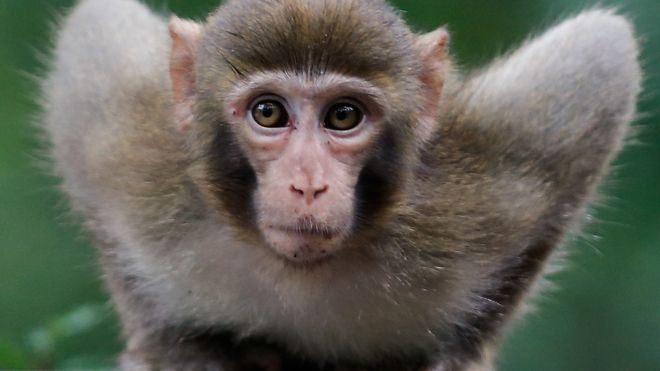Group Group I (dsDNA) Subfamily Alphaherpesvirinae Scientific name Macacine herpesvirus 1 Rank Species | Family Herpesviridae Genus Simplexvirus Higher classification Simplexvirus | |
 | ||
Similar Influenza A virus subt, Picornavirus, Hepadnaviridae, Coxsackievirus, Arenavirus | ||
Herpes simian B virus (Macacine herpesvirus 1 (formerly Cercopithecine herpesvirus 1, CHV-1), Herpesvirus simiae, B virus) is the endemic simplexvirus of macaque monkeys. B virus is an alphaherpesvirus, which consists of a subset of herpes viruses that travel within hosts using the peripheral nerves. As such, this neurotropic virus is not found in the blood.
Contents
In the natural host, the virus exhibits pathogenesis similar to that of herpes simplex virus (HSV) in humans. Conversely, when humans are zoonotically infected with B virus, patients can present with severe central nervous system disease, resulting in permanent neurological dysfunction or death. Severity of the disease increases for untreated patients, with a case fatality rate of approximately 80%. Early diagnosis and subsequent treatment are crucial to human survival of the infection.
Linked with more than two dozen deaths since its discovery, B virus is the only identified nonhuman primate herpesvirus that displays severe pathogenicity in humans. The last identified case of human B virus infection occurred in 2008, with the last known fatality occurring in 1997 when researcher Elizabeth Griffin was splashed in the eye at Yerkes National Primate Research Center. Proper personal protective equipment is essential when working with macaques, especially those animals that have tested positive for the virus. Bites, scratches and exposures to mucous membranes, including the eye, must be cleaned immediately.
Since the identification of the virus in 1932, there have been 31 documented cases of human B virus infection, 21 of which led to death. At least 20 of the patients developed some degree of encephalitis.
History
Herpes B virus was first identified in 1932 following the death of Dr. William Brebner, a young physician who was bitten by a monkey while researching the virus that causes poliomyelitis. Soon after, Brebner developed localized erythema, followed by lymphangitis, lymphadenitis and, ultimately, transverse myelitis. Neurologic tissues obtained during Dr. Brebner’s autopsy revealed the presence of an ultrafilterable agent that appeared similar to HSV. This isolate was originally termed “W virus.”
Within a year of Brebner’s death, Dr. Albert Sabin identified an unfilterable agent from the same tissue, which he later named B virus. Sabin further described the lethality of B virus by showing that infectivity was independent of the route of inoculation. Additionally, it was observed that B virus induced immunologic responses similar to HSV-1, as well as shared similarities to HVP-2 and Langur herpesvirus, two other nonhuman primate alphaherpesviruses.
By 1959, B virus was identified as the causative agent in 17 human cases, 12 of which resulted in death. Approximately 50 cases had been identified by 2002, although only 26 were well documented. The latest identified case of B virus occurred in 2008, per the National B Virus Resource Center in Atlanta, GA.
Improvements in handling human cases have been made in the past several decades. Between 1987 and 2004 the rate of mortality has decreased, largely due to the addition of new forms of treatment and improved diagnosis. There have been a total of 5 fatalities related to Herpes B virus in this timeframe.
Traveling to an area where macaques are known carriers of the virus and interacting in close contact in areas such as temples poses a risk of exposure. However, even in endemic areas, human cases are rare. There have been no known cases of Herpes B virus in travelers.
Viral Structure
B virus is approximately 200 nm in diameter and has a structure almost identical to that of HSV1 and HSV2. It has an icosahedral capsid (T=16) which consists of 150 hexons and 12 pentons, formed from 6 proteins. The envelope is loose around the viral capsid and contains at least 10 glycoproteins which are critical for adsorption and penetration into host cells. The tegument containing at least 14 viral proteins lies between the capsid and the envelope. The tegument proteins are involved in nucleic acid metabolism, DNA synthesis and processing of proteins. The proteins in the tegument are thymidine kinase, thymidylate synthetase, dUTPase, ribonuclease reductase, DNA polymerase, DNA Helicase, DNA Primase and Protein Kinases.
Viral Genome
The B virus genome was fully sequenced in 2003 from an isolate found in a rhesus macaque. Like all herpes viruses, the B virus genome contains double-stranded DNA and is approximately 157 kbp in length. Two unique regions (UL and US) are flanked by a pair of inverted repeats, two of which are found at the termini, with the other two internally located. This arrangement, which is identical in nature to HSV, results in four sequence-oriented isomers. Cytosine and guanine nucleotides represent 75% of the sequence.
Sequence analyses suggest that B virus and HSV types 1 and 2 most likely diverged from a common ancestor during the evolution of these pathogens. Each gene-encoded glycoprotein, including gB, gC, gD, gE and gG, has approximately 50% homology with HSV, with a slightly higher predilection towards HSV-2 over HSV-1. Additionally, glycoprotein sequences have demonstrated that all cysteine residues are conserved, as are most glycosylation sites. One key difference between the B virus and the HSVs is that B virus does not have a homolog of the HSV γ134.5 gene, which codes for a neurovirulence factor. This indicates that B virus has different mechanisms from HSV for replicating inside nerve cells, which could explain the drastically different effects of these viruses on humans.
Treatment
Aciclovir has prevented progression of the disease in some patients and may be life saving. Though is thought to only be 10% as effective against B virus as HSV1. Prompt treatment is essential to prevent permanent neurological impairment.
Upon potential infection, samples from both the human and, when possible, the macaque should be sent for B virus diagnostic testing.
